Summary:
- ACADIA Pharmaceuticals and Soleno Therapeutics are both conducting late-stage trials for the treatment of Prader-Willi Syndrome.
- PWS is a rare disease characterized by various physical and developmental challenges.
- Acadia is an established commercial stage company, while Soleno is a clinical stage company focused on PWS.
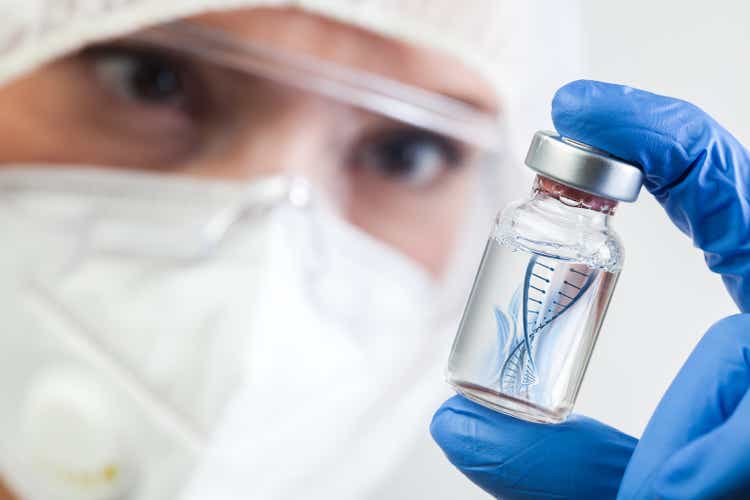
Plyushkin
I have followed and chronicled the ups and downs of ACADIA Pharmaceuticals (NASDAQ:ACAD) since 07/2017’s “Acadia: Order For Central Nervous Systems In Need”. My most recent Acadia article was “Acadia Pharmaceuticals: Nuplazid’s (Pimavanserin) Last Hurrah” (“Hurrah”).
As for Soleno Therapeutics (NASDAQ:SLNO) this is my very first analysis of it. The indication that ties these two together in this article is their respective late stage trials in treatment of Prader-Willi Syndrome [PWS].
PWS is a devastating disease. Luckily it is quite rare; unluckily it still presents in between 1:10,000 to 1:30,000 live births annually in the US. As far as its symptoms, PWS ebbs and flows in a maddening sequence with:
… numerous implications on metabolic, endocrine, and neurologic systems. It also presents with behavior and intellectual difficulties as well. PWS is mainly characterized by severe hypotonia with feeding difficulties in the first years of life followed by global developmental delays, hyperphagia, and gradual development of morbid obesity at about three years of age. It is also recognizable by typical facial features, strabismus, and other musculoskeletal conditions.
Life can trump art at every turn; PWS trumps “The Gods Must Be Crazy” starting with feeding difficulties developing to morbid obesity.
In this article I will reference:
- Acadia’s 01/09/2023 J.P. Morgan Healthcare Conference Presentation as the “Acadia Presentation“;
- Acadia’s Q3, 2023 earnings call as the “Acadia Call“
- Soleno’s 01/2024 Corporate Presentation as “Soleno’s Presentation“.
- Soleno’s Q3, 2023 Corporate Update and Third Quarter 2023 Financial Results press release as “Soleno’s Release”.
Acadia is an established commercial stage company while Soleno is a clinical stage company primarily focused on PWS.
Acadia
Acadia had a market cap ~$4.53 billion as of 01/21/2024. According to Seeking Alpha’s Ratings Summary graphic below Acadia rates a “BUY” by all analysis that it tracks:
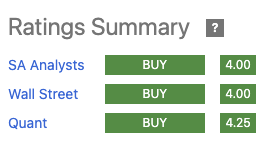
seekingalpha.com
Acadia has a conventional pipeline as reflected by its slide 12 below from the Acadia Presentation:
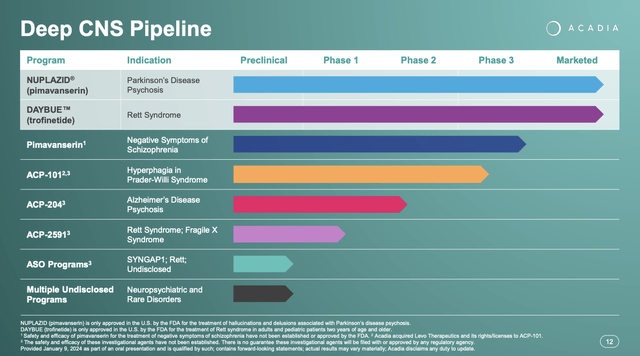
seekingalpa.com
Its two marketed therapies are NUPLAZID and DAYBUE. As reported by CEO Davis in the Acadia Call, Acadia generated quarterly NUPLAZID revenues of ~$149 million and DAYBUE revenues of ~$67 million.
He further announced that Acadia paid $100 million for worldwide rights to trofinetide. Aside from this payment, it was cash flow positive for the quarter. Depending on its business development activities it expects to remain cash flow positive.
ACP-101 in treatment of hyperphagia is Acadia’s PWS candidate therapy. Acadia is studying it in a 170 patient phase 3 study. It has an estimated completion date in 06/2026.
Soleno
Soleno had a market cap ~$1.33 billion as of 01/21/2024. According to Seeking Alpha’s Ratings Summary graphic below Soleno rates a “STRONG BUY” by Wall Street Analysts. Seeking Alpha Analysts and Seeking Alpha’s quant system are more restrained, rating it a “HOLD”:
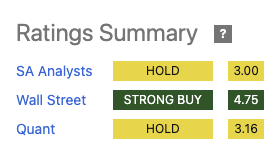
seekingalpha.com
In terms of pipeline as best I can tell Soleno’s PWS therapy, DCCR (diazoxide choline) extended-release tablets, is the entire ballgame. In its latest 10-K (p. 3) it describes DCCR’s potential uses beyond PWS. In addition to a handful of PWS trials, Soleno lists a single additional (phase 2) trial for DCCR in treatment of a variety of genetic obesities on clinical trials.gov.
Soleno’s Presentation slide 3 lists its strategic highlights. As might be expected it is focused on DCCR. Of interest, note that it boasts of a cash runway extending beyond its potential launch of DCCR.

investors.soleno.life
The Soleno Presentation slide 33 financial highlights offer further details on its financial condition:
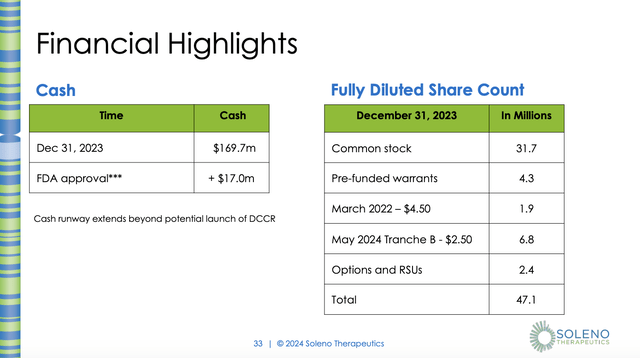
investors.soleno.life
As stated in the Soleno Release its quarterly R&D expenses are running at ~$6 million and its G&A at $3.3 million for a total of <$10 million. This puts its annual expenses up to ~$40 million.
As I write on 01/21/2024 Soleno’s PWS candidate therapy is the more advanced.
Overview
Lacking an approved drug therapy, recommended treatments for PWS symptoms are mildly palliative at best; they include:
- for newborns with subnormal sucking ability — special nipples;
- in response to voracious drive to overeat that kicks in ~2-4 years old — annual weight and BMI checks, imposition of extreme measures to limit access to food that is not part of approved diet;
- age appropriate physical therapy from age 3 on;
- strict behavioral therapy to limit variety of problematic compulsions such as — excessive anger, extreme willfulness, obsessive compulsive behavior;
- special needs programs for speech, learning and other issues;
- ongoing specialist medical treatments by a wide variety of specialists to address issues from defective vision to curvature of the spine to genital abnormalities.
In sum those who have a PWS afflicted child have to redirect their resources and energies to address the child’s needs. Obviously therapeutic assistance will be avidly welcomed.
Soleno’s DCCR candidate PWS therapy is moving ahead.
In Soleno’s latest 10-K (p. 3) it describes DCCR’s MOA in contributing to a reduction in hyperphagia. It also describes its development pathway with an initial 1973 US approval of diazoxide as an intravenous formulation for the emergency treatment of malignant hypertension. Subsequently in 1976:
…immediate-release oral formulations including Proglycem® Oral Suspension and Capsules, or Proglycem, were approved, and there has been nearly 40 years of use of the 2-3 times a day, orally-administered drug product in the approved ultra-rare indications related to hyperinsulinism. …There is extensive data on short term and chronic use of Proglycem in children with congenital hyperinsulinism, or CHI, and in adults with insulinoma. Insulinoma patients tend to be older, with 50% of them over 70 years old. Published data have reported that the average duration of use of Proglycem in certain CHI and insulinoma patients is 5 years and 7 years, respectively.
It then goes on to describe the process of developing the extended release tablets DCCR. The rationale was to improve safety and bioavailability and reduce the frequency of dosing of orally-administered diazoxide.
At pps. 4-5 the 10-K goes on to describe Soleno’s DCCR clinical trials. Its phase 3 DESTINY PWS reported top line results in 06/2020. It did not meet its primary endpoint of change from baseline in hyperphagia. Management was nonplussed; it focused on significant improvements observed in two of three key secondary endpoints.
It allowed subjects who completed the DESTINY PWS study to enroll in a long-term, safety extension study (C602). In 09/2021 it announced top-line results from the analysis of one year data from C602. It showed both:
- significant reduction in hyperphagia and all other PWS behavioral parameters and
- statistically significant improvements compared to the natural history of PWS from the PATH for PWS Study (PfPWS) over a one year treatment period — PfPWS being an ongoing study sponsored by the Foundation for Prader-Willi Research evaluating the natural history of subjects with PWS in more than 700 families.
Moving beyond the 10-K, Soleno’s latest relevant SEC filing is its Prospectus (the “Prospectus“) dated 01/02/2024. At page it advises:
The FDA … minutes from a Type C meeting in January 2022 … recommended additional controlled data be included in a New Drug Application (NDA), … they were receptive to a study design involving participants currently enrolled in Study C602, our ongoing open-label extension study to generate the data necessary to support an NDA. In March 2022, we submitted a proposal to add a randomized withdrawal period to Study C602 to obtain additional controlled data requested by the FDA to support approval of an NDA for DCCR. The randomized withdrawal (RW) period of Study C602 was a multi-center, randomized, doubleblind, placebo-controlled study … of DCCR in approximately 80 patients with PWS at … sites in the U.S. and … U.K. … On September 26, 2023, … [w]e announced that the study had met the primary endpoint and that there was a highly statistically significant difference in the change from baseline in HQ-CT Total Score for DCCR Compared to placebo (p=0.0022). Further we announced that we intend to submit an NDA for DCCR for treatment of PWS mid-year 2024. The FDA has acknowledged that data from the study has the potential to support an NDA approval for DCCR.
Acadia’s PWS candidate therapy ACP-101 is still enrolling patients.
Unlike Soleno’s DCCR, Acadia’s ACP-101 is far from its lead therapy. Acadia’s BD sleuths have been on the lookout for potential late stage acquisition targets to match or better their 08/2018 Rett Syndrome licensing deal. In 06/2023 Acadia acquired Levo Therapeutics and worldwide rights to ACP-101(intranasal carbetocin).
The release announcing the deal advised:
We recently met with the FDA and reached alignment to further evaluate the 3.2 milligram dose of ACP-101 in a pivotal Phase 3 study,” said Doug Williamson, Acadia’s Executive Vice President, Head of Research and Development. “If positive, we plan to promptly submit a new drug application for the treatment of hyperphagia in PWS to the FDA.”
Acadia Presentation slide 16 describes its Prader-Willi trial:
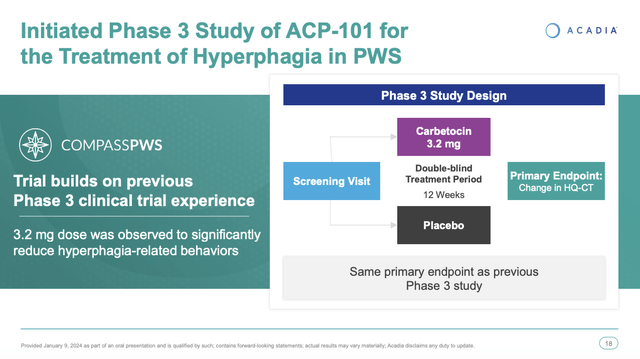
ir.acadia.com
Neither this slide nor the Call list any timeline for a potential filing. The entry for this trial on clinical trials.gov sets an primary completion date in 06/2026 this puts it well behind Soleno’s DCCR.
After two reverse splits Soleno share prices finally took off in 09/2023 following Study C602 data.
Soleno shareholders have had a rough ride; after descending to ~$0.50 in 10/2017 it reverse split them up to >$2.00 then again in 08/2022 they dropped even lower to <$0.20. The company imposed a second reverse split in 08/2022, this time a one-for-fifteen (1-15) reverse split taking its shares back up towards $2.00.
Reverse splits are merely mechanical in the sense that they are simply a reslicing of the corporate pie into fewer pieces. However when tracking corporate share performance over time it is helpful to understand when such splits have happened.
Soleno shares rocketed upwards in 09/2023 when it issued its release announcing top-line results from randomized withdrawal period of study C602 of DCCR. Shares closed on 09/25/2023 at $4.43; they opened on 09/26/2023 at $21.00. As I write on 01/21/2024 they most recently closed at $47.01.
The top line results as reported in the 09/2023 release included CEO Bhatnagar announcements:
…highly statistically significant results from the randomized withdrawal phase of Study C602, … [that] support… planned submission of a New Drug Application to the U.FDA mid-year of next year [2024].
Wow an NDA in mid 2024 implies a potential approval in early 2025.
Conclusion
Prader-Willli families are no doubt watching Soleno and Acadia as their respective PWS champions line up. Sundry other approaches are in development but Soleno’s DCCR and Acadia’s ACP-101 are the most advanced.
In terms of investment Soleno has the lead in Prader-Willi candidates, but it has little else to bolster its chances. It is at best a “Hold” for those brave enough to speculate in a long shot for a quick FDA approval of DCCR. It will likely soon be back in penny stock territory if this runs into roadblocks.
Acadia on the other hand has underlying quant system metrics supporting a “Buy” rating. Its ACP-101 is pretty much gravy. Soleno’s market cap exceeding $1 billion shows the significant value the market accords potential PWS candidates. I rate Acadia a “Buy” based on the unrecognized value of ACP-101.
Analyst’s Disclosure: I/we have no stock, option or similar derivative position in any of the companies mentioned, but may initiate a beneficial Long position through a purchase of the stock, or the purchase of call options or similar derivatives in ANY COMPANY MENTIONED over the next 72 hours. I wrote this article myself, and it expresses my own opinions. I am not receiving compensation for it (other than from Seeking Alpha). I have no business relationship with any company whose stock is mentioned in this article.
Seeking Alpha’s Disclosure: Past performance is no guarantee of future results. No recommendation or advice is being given as to whether any investment is suitable for a particular investor. Any views or opinions expressed above may not reflect those of Seeking Alpha as a whole. Seeking Alpha is not a licensed securities dealer, broker or US investment adviser or investment bank. Our analysts are third party authors that include both professional investors and individual investors who may not be licensed or certified by any institute or regulatory body.
